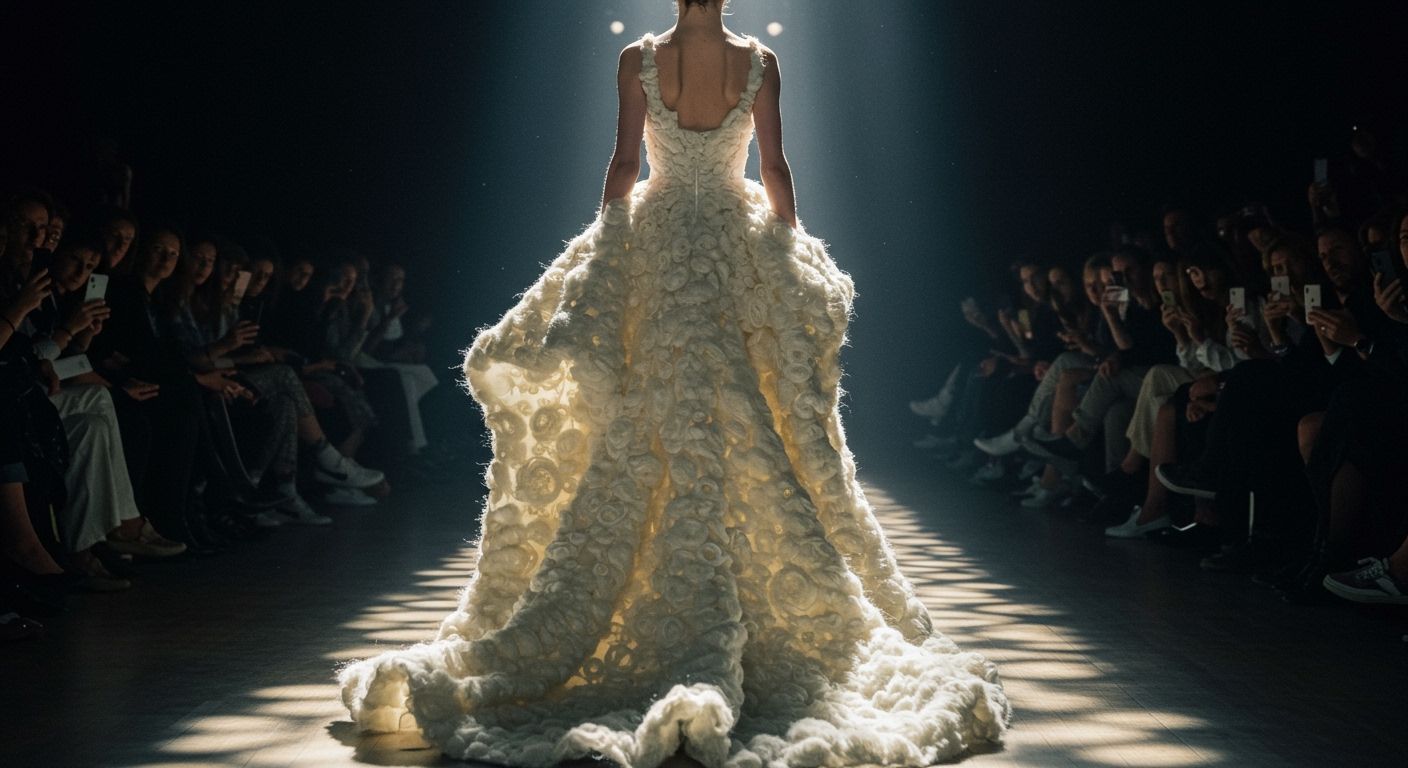Paris, France – In a significant convergence of biotechnology and high fashion, Japanese biotech venture Spiber Inc. and internationally acclaimed Dutch haute couture designer Iris van Herpen unveiled a groundbreaking collaborative piece during Paris Haute Couture Fashion Week Autumn/Winter 2025. The partnership culminated in the debut of a unique bridal look, presented on the prestigious Parisian runway, signaling a potential paradigm shift towards innovative and sustainable materials in the world of luxury design.
This collaboration brings together two entities with parallel histories of radical experimentation, both founded in the year 2007. Spiber has been at the forefront of biomaterial engineering, specifically pioneering the development of man-made protein fibers. Simultaneously, Iris van Herpen has established herself as a visionary in avant-garde couture design, renowned for pushing the boundaries of traditional craftsmanship through technological integration and artistic exploration.
A Synergistic Foundation in Innovation
The synergy between Spiber and Van Herpen stems from their shared commitment to innovation and a forward-thinking approach to creation. Spiber’s mission centers on developing advanced materials through biological processes, offering alternatives to conventional resource-intensive fibers. Van Herpen’s design philosophy consistently seeks to fuse art, science, and technology, translating complex biological structures and concepts into wearable sculptures. This common ground provided a fertile foundation for a partnership aimed at demonstrating the aesthetic and structural potential of next-generation biomaterials in the most demanding realm of fashion – haute couture.
The choice of Paris Haute Couture Fashion Week Autumn/Winter 2025 for this unveiling underscores the significance of the collaboration. Couture represents the pinnacle of craftsmanship and material innovation in fashion. Presenting a creation utilizing a novel biotech fiber on this platform grants it immediate credibility and visibility within the global fashion elite, signaling that materials derived from processes like fermentation are not merely conceptual but are ready for high-level application.
Introducing Brewed Protein™ Fiber
The centerpiece of the collaboration, the unveiled wedding dress, was meticulously crafted using Spiber’s innovative man-made protein, specifically their Brewed Protein™ fiber. This material is a product of Spiber’s proprietary fermentation technology, a process that utilizes microorganisms to produce proteins that can then be spun into fibers. This method represents a significant departure from traditional fiber production, which often relies heavily on petroleum-based resources or conventional agriculture.
Spiber describes Brewed Protein™ fiber as a premium, plant-based fiber offering distinct characteristics that are highly desirable for wearable creations. Its key attributes include exceptional lightness and remarkable softness, qualities paramount in the creation of comfortable yet structurally ambitious couture pieces. Beyond its tactile and aesthetic appeal, Brewed Protein™ fiber is positioned as representing a new category of protein fibers and, significantly, a circular solution within the textile value chain. The ambition is for materials like Brewed Protein™ to contribute to a more sustainable future for fashion by reducing reliance on non-renewable resources and offering potential pathways for biodegradability or material recovery.
The Significance of a Bridal Look
The decision to showcase the material in a bridal look holds symbolic weight. A wedding dress often embodies dreams, future aspirations, and the beginning of a new journey. Presenting a gown made with a revolutionary, sustainably-oriented material like Brewed Protein™ fiber within this context can be interpreted as a statement about the future of fashion itself – one that is intertwined with technological advancement and environmental responsibility. It positions the material not just as a functional substitute but as one capable of realizing visions of beauty and artistry at the highest level.
Iris van Herpen’s atelier is known for its intricate, often complex construction techniques that blend traditional couture skills with cutting-edge digital processes and material manipulation. Integrating Brewed Protein™ fiber into a Van Herpen design speaks volumes about the material’s versatility and ability to be worked into elaborate forms and textures required by her unique aesthetic. The collaboration likely involved extensive research and development to understand how the Brewed Protein™ fiber behaved under various design and construction techniques, pushing both the material’s capabilities and the designer’s creative process.
Pushing the Boundaries of Fashion and Science
The partnership between Spiber and Iris van Herpen is more than just a material supply agreement; it is a collaboration that seeks to push the boundaries of what is possible at the intersection of fashion and material science. By bringing a cutting-edge biotech material into the highly visible and influential world of haute couture, they aim to inspire broader adoption of sustainable alternatives across the fashion industry, from luxury to ready-to-wear.
The unveiling at Paris Haute Couture Fashion Week AW2025 serves as a powerful demonstration of how innovative materials can not only meet the stringent demands of high fashion but also open up entirely new creative avenues for designers. As the fashion industry faces increasing pressure to reduce its environmental footprint, collaborations like this offer tangible examples of scalable, performance-driven materials that can contribute to a more circular and less impactful future. This moment marks a notable step forward in the ongoing dialogue about sustainability, technology, and artistry in fashion, championed by two pioneers in their respective fields who began their innovative journeys in 2007.





